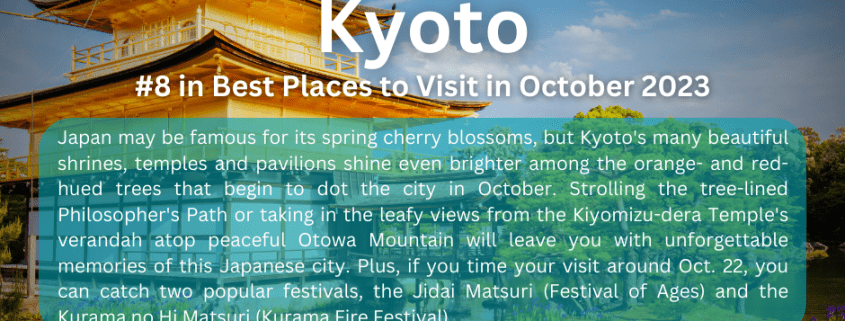Kyoto #8 in Best Places to Visit in October 2023
Why Go To Kyoto
Cherry blossom petals caught on a breeze, the burble of a water fountain permeating the silence of a peaceful rock garden, a pair of elegantly dressed geisha flitting between wooden tea houses … Kyoto is the Japan of the past, the Japan of your imagination. Standing as Japan’s capital from A.D. 794 to 1868, Kyoto has thrived as a hub for Japanese culture, art and education. Given the city’s respect for its history, it’s not surprising that millions of people visit Kyoto each year for a snapshot of imperial Japan.
But no matter where you point your lens, modern-day Japan is sure to make it into the frame. Centuries-old Shinto shrines and pagodas share the city with the headquarters of companies like Nintendo and electronics manufacturer Kyocera. Kyoto’s blend of ancient and contemporary makes it a vibrant city that certainly isn’t stuck in the past.
Best Months to Visit
The best times to visit Kyoto are from March to May and from September to November when the weather is the mildest. However, the blooming cherry blossoms in spring and the vibrant fall foliage are big tourist draws, so be prepared for higher hotel rates and fewer vacancies. Crowds do wane a bit in the summer and winter, but June’s sticky humidity and January’s chilly temperatures are too uncomfortable for some travelers.
Culture & Customs
Being the epicenter of Japan’s cultural heritage, Kyoto is certainly geared toward tourists. However, that doesn’t mean that the city is an amusement park – locals are still deeply rooted in customary Japanese etiquette and visitors should respect the rules. For example, you may be asked to remove your shoes or stow your umbrella upon entering a house, temple or shrine. Photography, eating and drinking are often prohibited within these structures, and it is polite to be silent while in a temple’s vicinity.
Photography is also a touchy subject when it comes to geisha in Gion. You can recognize geisha by their colorful traditional kimonos, elaborate hairstyles, white-painted faces and red lips. Remember that geisha are neither prostitutes (as many westerners believe) nor theme park mascots. These women are respected entertainers and keepers of ancient Japanese traditions. If you must photograph them, do so from a respectful distance or with explicit permission.
The official language in Kyoto is Japanese. However, you might hear some people in Kyoto use the Kansai dialect, which is regarded as a more elegant and formal version of the language. It diverges from common Japanese in a few ways. For example, “thank you,” in the Kansai dialect is “ookini,” while in standard Japanese it’s “arigato.” When meeting new people, it is customary to bow, though handshakes are becoming more commonplace. If you are visiting someone’s home, Japanese custom dictates you should bring a gift (a small token from your home country is usually acceptable).
Kyoto’s official currency is Japanese yen (JPY). One American dollar (USD) equals about 110 yen (JPY), but you’ll want to check the current exchange rate before you visit. And while your daily budget in Kyoto may have to be a little higher than in other cities, you won’t have to worry about tipping, since it is not customary here.
What to Eat
Kyoto is famous for its kaiseki ryori style of dining, a traditional and formal way of eating; shojin ryori, composed strictly of vegetarian dishes and inspired by the diet of Buddhist monks; obanzai (Kyoto home-style cooking); and other popular Japanese fare such as ramen, sushi and udon. And, as in any large city, there is a variety of international cuisines. For those looking to try a kaiseki meal, head to the Pontocho and Gion districts of Kyoto. Budget travelers beware: Traditional kaiseki dinners can be expensive. To enjoy a kaiseki meal without blowing your budget, consider a breakfast or lunch instead. Kaiseki restaurants often offer a sample of their dinner selections at half the price for breakfast or lunch.
Tofu, a local Kyoto specialty, is a common ingredient in shojin ryori and can be found in many local restaurants. Look for yudofu, soft tofu simmered with vegetables in broth on menus, a very popular dish. Meanwhile, foodies shouldn’t miss the Nishiki Market in central Kyoto to see and sample all sorts of local delicacies, including tsukemono (Japanese pickles), wagashi (Japanese confections) and plenty of fresh fish.
While you’re enjoying your meal, keep a few etiquette rules in mind: Never pass food with chopsticks or use them to point at things on the table; passing food with chopsticks is a big faux pas only reserved for funeral rituals. Equally rude: sticking your chopsticks vertically into a bowl of rice. If you’re done with your chopsticks, simply place them sideways on your plate.
Getting Around Kyoto
The best way to get around Kyoto is by bus and on foot. The abundance of English-language signs and announcements make Kyoto’s bus systems easy for visitors to navigate. But all those bus fares can add up, so put on some comfortable shoes and get ready to do some strolling as well. The city’s subway can also come in handy, but its two lines don’t have the breadth and scope of the bus system. Taxis are also a viable transportation option, especially at night.
Most travelers fly into Osaka’s Kansai International Airport (KIX), which is just 60 miles southwest of Kyoto. The fastest and most direct way to get from Kansai International Airport to Kyoto is to take the JR West Airport Express HARUKA train. The trip takes about 75 minutes and costs 3,600 yen (about $32). Alternatively, you can take MK Taxi’s Skygate Shuttle from the airport to Kyoto for 4,200 yen (about $37) per person (just remember to book your shuttle at least two days in advance), however because it is a shared service, it can be more time-consuming than if you were to take the train.
Bus
Buses are your best bet for getting to and from Kyoto’s top attractions. They feature electronic signs and announcements in English, and many leave directly from Kyoto Station’s Karasuma stop. The green and white Kyoto City Buses hit most of the city’s major sites, but even better are the Raku Buses (routes 100, 101 and 102), operated by the Kyoto City Bus. Raku Buses, which leave from platform D2 at Kyoto Station, will shuttle you quickly between tourist areas, skipping most non-tourist stops. Kyoto City Buses and Raku Buses cost 230 yen (about $2.35) per trip, but you can purchase a one-day bus pass for 600 yen (about $5.50) if you plan on riding a lot (kids younger than 12-ride for half-price). You may purchase bus passes from the bus driver or from the information center outside Kyoto Station. Just remember to enter the bus from the back door, and pay at the front door as you exit the vehicle. If you don’t have a pass, make sure you have the correct change.
Subway
With only two lines, Kyoto’s subway system isn’t nearly as extensive as its bus routes. There’s the north-south Karasuma Line and the east-west Tozai Line. With the subway, you can bypass some of the street traffic associated with buses and taxis, but you likely won’t be able to rely on subways alone. You can reach several top attractions, including Nijo Castle, Gion, the Nanzen-ji Temple as well as downtown Kyoto and the Southern Higashiyama district, home to the Kiyomizu-dera Temple and Sanjusangendo, among other must-sees.
Like the buses, the subway features English-language signage and announcements. Subway fares are calculated by distance traveled and range from 210 yen (about $1.85) to 350 yen (about $3.10), with discounts for children. You can buy tickets from the automatic ticket machines located in the subway stations. The subway runs between 5:30 a.m. and 11:30 p.m. daily.
On Foot
Since public transportation fares can add up quickly, you should plan on doing a fair amount of exploration on foot. And you’ll be happy to know that Kyoto boasts plenty of areas that are great for walking. A particularly famous route is the Philosopher’s Walk, which will take you along a tree-lined canal pathway and past a number of shrines.
Taxi
You can hail a taxi in Kyoto from any curb, or you can find one at a hotel or marked taxi stand. Taxis are metered and most drivers know English, though it is always a good idea to keep your hotel’s address handy to show the driver. Taxis are available in several different sizes; small taxis can transport up to four passengers while large ones carry five. Though it can vary, most taxis cost 640 yen (less than $6) for the first 2 kilometers (about 1¼ miles). Two trusted taxi companies are MK (topped with a heart logo) and Yasaka (topped with a clover logo). Both MK and Yasaka usually accept credit cards, but you should verify with the driver before hopping in the back seat.
Bicycle
Kyoto is a great place to explore on two wheels when the weather is nice (read: spring and fall). The grid layout of the streets, the bounty of English-language signage and relatively flat terrain make the city extremely easy to navigate on a bike. You can rent a bike starting at 1,000 yen (about $9) a day from the Kyoto Cycling Tour Project, which is a short walk from the north exit of Kyoto Station. During the spring and the fall, biking might even be faster than taking the bus, and let’s face it – it’s great exercise and a nice way to enjoy Kyoto’s outdoor scenery. The Kyoto Cycling Tour Project and J-Cycle are two well-reviewed companies.
Start Saving with iTravelDirect’s Exclusive Travel and Lifestyle Benefits Membership
CLICK HERE to Test-Drive our Guaranteed Savings
We offer a 110% Price Guarantee – Find a lower price anywhere online and we will refund you 110% of the difference.
CLICK HERE for a full list of services and Membership Discounts.
When you join iTravelDirect, you’ll have full access to all club benefits.
Your membership gives you the freedom to travel when you want, to where you want.
And you won’t find lower rates anywhere, guaranteed. So, pack your bags and start planning that vacation of a lifetime today!












Leave a Reply
Want to join the discussion?Feel free to contribute!